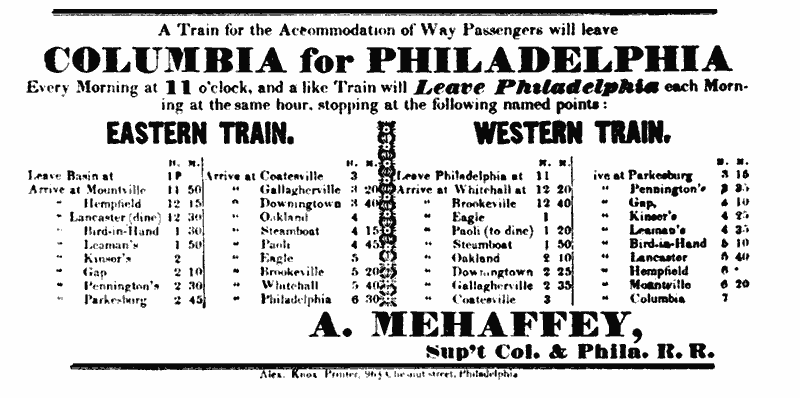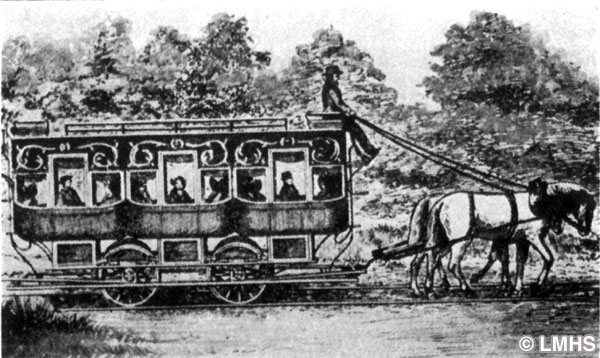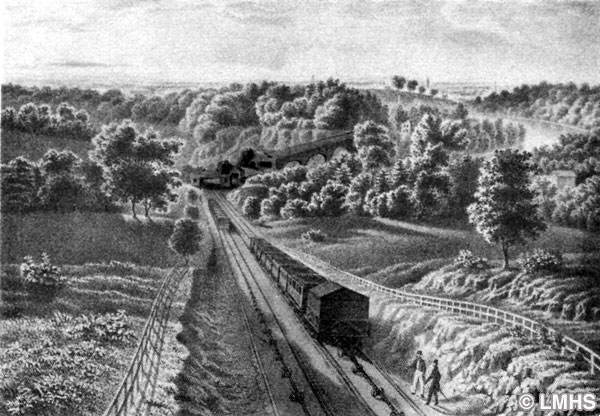The Philadelphia & Columbia Railway
A Ride on The Main Line
The War of 1812 had ended and the country was expanding by extending its borders westward. New York, Baltimore and Philadelphia were the major seaports which stood to benefit the most in trade to the west. The road system could not handle the increased traffic so we entered into the age of canals, which offered faster service and were cheaper to operate.
New York built the Erie Canal which joined the Hudson River with Lake Erie, thus providing a through waterway from New York City to the Great Lakes. The Erie Canal opened in 1825.
Maryland, replacing their National Road, began the construction of the Chesapeake and Ohio Canal which connected Baltimore with the Ohio River.
As a counter measure, Pennsylvania decided that it wanted to develop its own canal system linking Philadelphia to the frontier city of Pittsburgh and authorized its construction. But when the survey was made, it was found that there was not enough water in the right places for a canal between the Delaware and the Susquehanna Rivers.
In March 1823, the Pennsylvania State Legislature issued a charter for the first railroad in the state. It authorized the construction of an 82 mile railway, from Philadelphia through Lancaster, terminating at Columbia (on the Susquehanna River), as part of the “Main Line of Public Works of the State of Pennsylvania.” The nickname, “The Main Line,” derived from this early Pennsylvania railroad.


A Government Venture
The Philadelphia & Columbia Railway was one of the earliest railroads in America and the first in the world to be built by a government rather than by private enterprise. The contracts for the work were granted by the Canal Commission, under whose supervision the line was operated. Considered a public toll road, individuals and companies paid tolls to the Commission for use of the rails. They also supplied their own horses, rolling stock and passenger or freight facilities.
The Philadelphia & Columbia Railway finally became operational on September 1832, with carts and wagons dragged by horse power on a 20-mile section which began in Philadelphia (at Broad and Vine Streets) and ended at Green Tree Inn, west of Paoli.
The first passenger cars were constructed on the same general design as the stage coaches and were nicknamed “fireflies,” so designated because of their brilliant red color. They were drawn by two horses, recruited from the Conestoga wagon traffic.
When the idea of locomotives was first conceived, there was great opposition on the part of those who either used the railway or lived near it. They declared that the engines would destroy the value of their property, and that the sparks from them would set fire to their houses and barns. It was not until April 1834 that the first train was drawn from Philadelphia to Lancaster by a locomotive, named the “Black Hawk.” Not until 1836 did locomotives finally displace horsepower. The Baldwin locomotives worked the best. The English ones, while well built, were found too light for the heavily curved and graded American tracks.
Eventually, “The Main Line” expanded from the Philadelphia & Columbia Railway to include the Eastern Division of the Canal (from Columbia to Hollidaysburg, 172 miles); the Allegheny Portage Railway (from Hollidaysburg to Johnstown, 36 miles, crossing the Allegheny Mountains); and the Western Division of the Canal (from Johnstown to Pittsburgh, 104 miles). This network carried passengers, but its primary purpose was freight.
The Railway Route
The railroad began in Philadelphia and headed in a westerly direction:
- It crossed the Schuylkill River at the Columbia Bridge and proceeded up the “Incline Plane” at Belmont Plateau.
- There it turned right and paralleled Belmont Avenue and then followed Conshohocken State Road into Lower Merion.
- Still paralleling Conshohocken State Road, it passed through the Cynwyd train station, up Bala Avenue and Bentley Road, and crossed behind the fire house.
- It then crossed over to the south side of Montgomery Avenue (Bowman’s Bridge).
- At All Saints Church, it crossed back over to the north side of Montgomery Avenue and went in front of the Lower Merion High School.
- From there it curved left onto Church Road and onto Coulter Avenue to the Athensville (Ardmore) train station.
- It followed the tracks of the R5 until Haverford where it again curved left onto (Old) Railroad Avenue to the intersection of Bryn Mawr Avenue and County Line Road.
- Here it followed Glenbrook Avenue until it crossed County Line Road, then Lancaster Avenue, then up Montrose Avenue and rejoined the R5 line at the Rosemont station where it continued west and left the Lower Merion area.

A New Direction
Shortly after the railroad opened, it became obvious that the “Incline Plane” at the Belmont Plateau was inefficient. Hauling cars up and down the grade created significant delays both to passengers and to freight. It wasn’t until October 1850 that the Broad & Vine to Athensville (Ardmore) line was abandoned and replaced with the 30th & Market Street to Athensville (Ardmore) line which remains today the route of the Paoli Local (R5).
In 1851, the abandoned line was purchased by the Philadelphia & Reading Railroad. The tracks from Broad and Vine to the Columbia Bridge were used by the Reading; the tracks from the “Incline Plane” west to Athensville were kept open for awhile as a possible detour route, but were eventually dismantled.

Development of the railroad locomotive marked the beginning of the decline of the canal system. Also, the builders thought that once the system was open, the receipts would pour into the state’s coffers. They failed to foresee the huge ongoing maintenance and operational cost required. Therefore, the state decided it wanted to get out of the railroad business. In 1857, the Pennsylvania Railroad, whose original charter was to construct a line from Harrisburg to Pittsburgh only, bought the Philadelphia & Columbia Railway for $7.5 million. To save money, the Pennsylvania Railroad merely upgraded the Philadelphia & Columbia Railway line tracks and the PRR now had a continuous route from Philadelphia all the way to Pittsburgh. On leaving Philadelphia, the first stop was at the White Hall station, located at the corner of Glenbrook and County Line Roads in Bryn Mawr.
